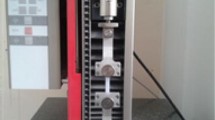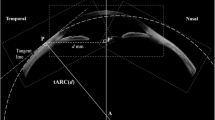Abstract
Background
The weakened biomechanical properties of the sclera is an important feature of myopic eyes. The quantitative evaluation in vivo of posterior scleral resistance to the elongation remains a challenge.
Methods
This study comprised 172 eyes from 86 subjects with a mean age of 20.6 years (range, 18–28 years). Ultrasound biometry was performed using an immersion technique and the A-scan device (the Biometer AL-1000 -TOMEY). The axial length of the eye was measured twice: before and during the application of an external pressure of 30 g on the eye. The difference between two mean values of AL measurements before and during the pressure application was considered as a degree of change in the axial length that resulted from the IOP elevation.
The data were entered into an Excel spreadsheet (Microsoft Corp.) for subsequent analysis. Statistical analysis was performed using SigmaPlot software (version 11.0, Systat Software, Inc.). A value of 0.05 or less was considered statistically significant.
Results
The means ± SD of axial changes before and during the external pressure for hyperopia, emmetropia, myopia 0.5–3.0 D, myopia 3.25–6.0 D, myopia 6.25–12.0 D and myopia over 12.0 D were as follows: 0.03 ± 0.01 mm, 0.05 ± 0.01 mm, 0.18 ± 0.07 mm, 0.31 ± 0.02 mm, 0.38 ± 0.07 mm, and 0.51 ± 0.9 mm, respectively. The difference among groups was statistically significant.
Conclusions
In conclusion, our study indicates that the biomechanical properties of the scleral coat, in terms of stretching and AL elongation, are measurable. The hypermetropic and emmetropic eyes possessed stiff sclera. The extent of AL remained practically unchanged during IOP elevation in these eyes. The absolute majority of the myopic eyes revealed a biomechanical weakness of the scleral shell. A higher degree of myopia was associated with increased AL elongation. Our approach to measuring the biomechanical properties of the sclera may have clinical significance in the future.


Similar content being viewed by others
References
Duke Elder S (1970) Pathological myopia. In: System of ophthalmology, vol. 5. Ophthalmic optics and refraction. Henry Kimpton, London, pp 300–362
Avetisov ES (1999) Myopia. “Medizina”, second edition, Moscow
Dashevsky AI (1962) Myopia. State publishing house of medical literature, Leningrad
Heine L, Comberg W (1958) Die Kurzsisichtigkeit oder Myopie. In: Lerhbuch und Atlas der Augenheilkunde. VEB Gustav Fischer Verlag, Jena, pp 106–117
Corrado BC (1983) The etiopathogenesis of degenerative myopia. Ann Ophthalmol 15(4):312–314
Sergienko NM, Kondratenko YN (1988) Hypothesis of pathogenesis of myopia. Ophthalmol zh 138–143
Tron EJ (1947) Variability of elements of the optical system of eye and its clinical significance. Publishing house of the Military Medical Academy, Leningrad
Spencer WH Sclera (1990) In: Ophthalmic pathology (4th edition), W. B. Saunders Company, pp. 334–371
Ward B, Thompson FB (1989) The myopias: pathogenesis and physiology. In: Myopia surgery. Anterior and posterior segments, Macmillan Publishing Co., pp 1–30
Ytteborg J (1960) The role of intraocular blood volume in rigidity measurements on human eyes. Acta Ophthalmol 38:410–436
Frieman E, Ivry M, Ebert E, Glynn R, Gragoudas E, Dennon J (1989) Increased scleral rigidity and age-related macular degeneration. Ophthalmology 96:104–108
Pallikaris IG, Kymionis GD, Ginis HS, KounisGA TMK (2005) Ocular rigidity in living human eyes. Invest Ophthalmol Vis Sci 46(2):409–414
Author information
Authors and Affiliations
Corresponding author
Additional information
The authors have no financial interests in any material or method mentioned in this work.
Rights and permissions
About this article
Cite this article
Sergienko, N.M., Shargorogska, I. The scleral rigidity of eyes with different refractions. Graefes Arch Clin Exp Ophthalmol 250, 1009–1012 (2012). https://doi.org/10.1007/s00417-012-1973-0
Received:
Revised:
Accepted:
Published:
Issue Date:
DOI: https://doi.org/10.1007/s00417-012-1973-0




